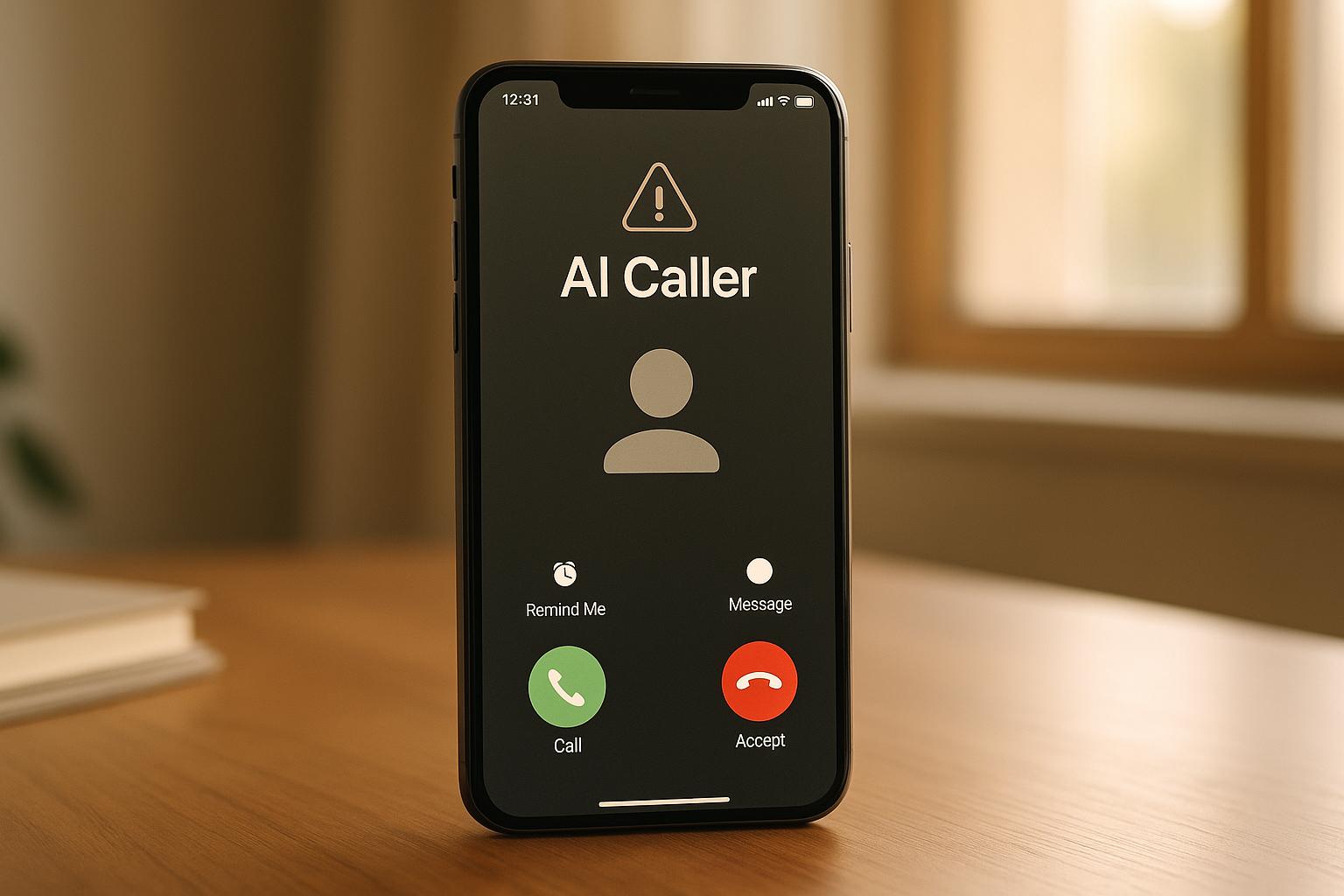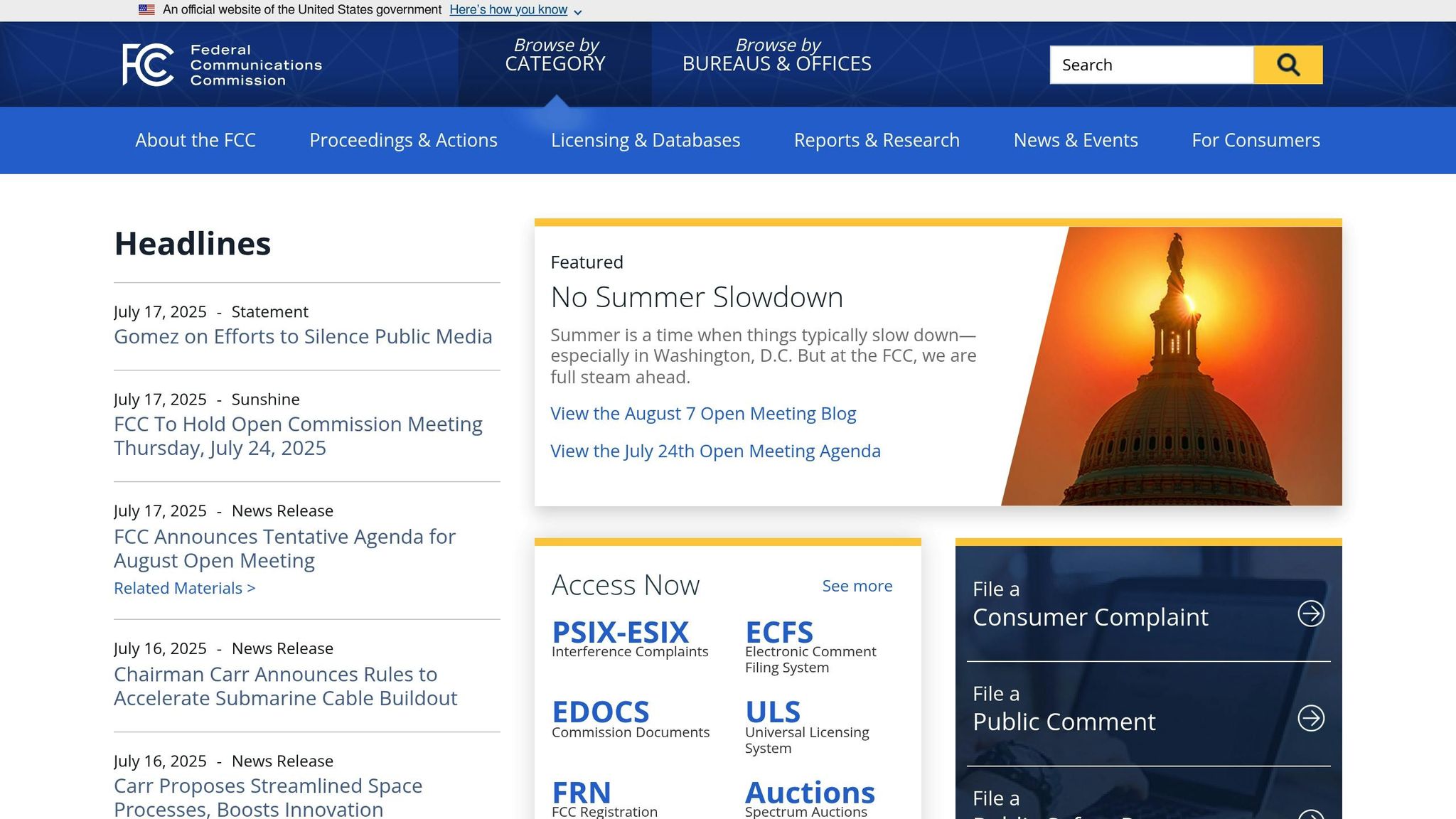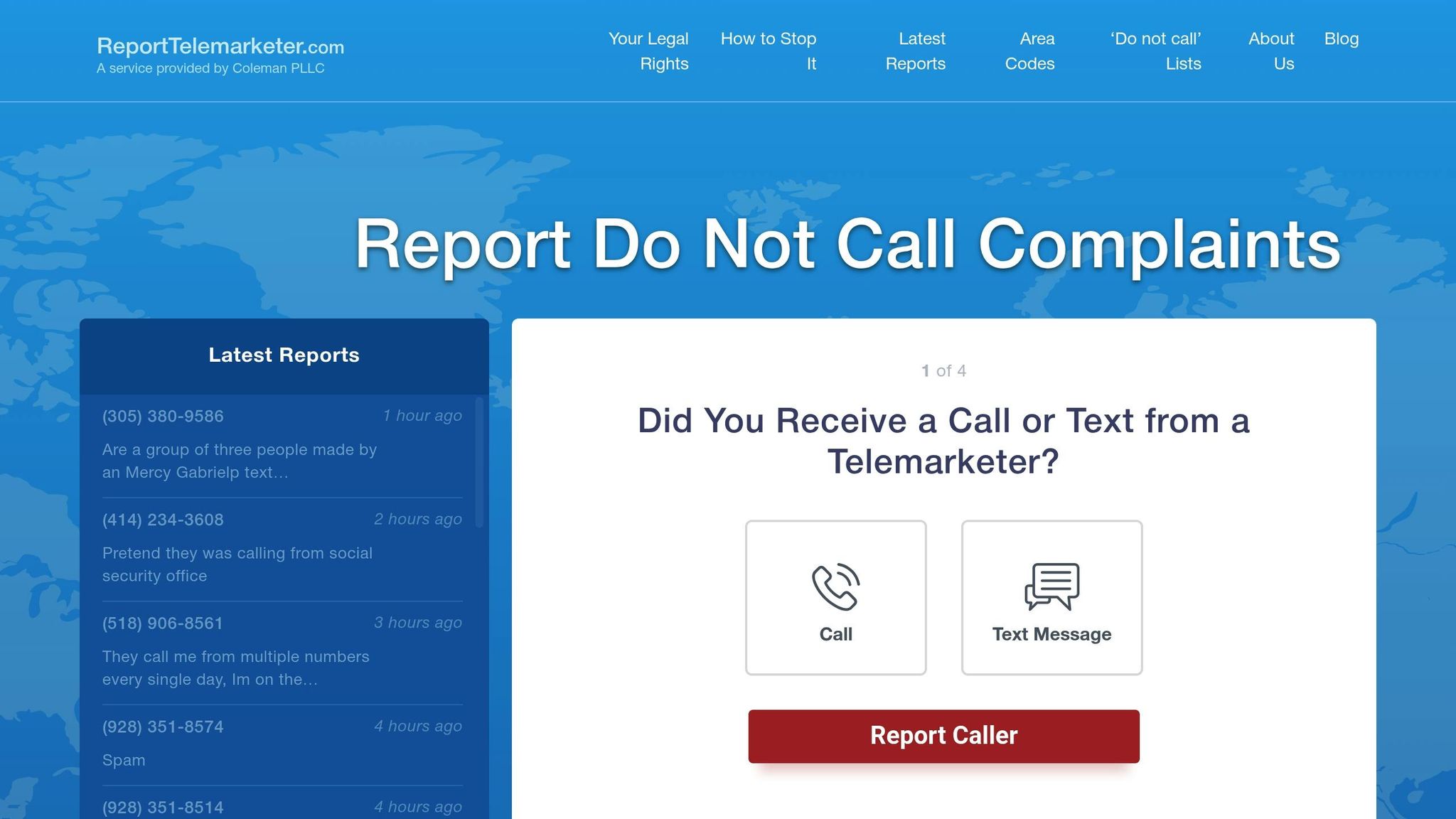
The FCC has introduced new rules to curb the rise of AI-generated robocalls and texts, offering consumers better protection and control. Here’s what you need to know:
- AI-generated voices now classified as "artificial voice": Calls using AI-generated voices require prior express consent from the recipient.
- Stricter consent rules: Businesses must obtain individual consent for each seller and honor opt-out requests within 10 business days.
- Disclosure requirements: Callers must disclose the use of AI at the start of a call, identify themselves, and share their purpose.
- Closing loopholes: The "lead generator loophole", which allowed excessive unrelated calls, is now restricted.
- Advanced enforcement tools: The FCC is using technology to detect and block fraudulent AI-driven calls.
These rules, effective April 11, 2025, aim to reduce scams, which defrauded Americans of $10 billion in 2024. Consumers can report violations to the FCC or services like ReportTelemarketer.com to hold bad actors accountable. Take control by understanding your rights and using opt-out options effectively.
FCC votes to outlaw scam robocalls that use AI-generated voices

What Counts as an AI-Generated Robocall
Understanding what qualifies as an AI-generated robocall is crucial for applying the FCC’s updated rules, which address the growing use of AI technologies in telecommunications.
How the FCC Defines AI Robocalls
The FCC has clarified that AI-generated voices fall under the Telephone Consumer Protection Act‘s (TCPA) definition of "artificial or prerecorded" voices. In a Declaratory Ruling, the agency stated that robocalls using AI-generated voices are considered "artificial" under existing law.
"Confirms that the TCPA’s restrictions on the use of ‘artificial or prerecorded voice’ encompass current AI technologies that generate human voices. As a result, calls that use such technologies require the prior express consent of the called party."
This definition applies broadly to any call leveraging AI to produce or mimic human speech. To further refine its approach, the FCC is working on a more detailed definition of "AI-Generated Call" specifically for outbound communications, aiming to differentiate these from other forms of automated calls.
Next, let’s explore the AI technologies impacted by these regulations.
Which Technologies Are Covered
The FCC’s rules target several types of AI technologies frequently used in robocalls. A key focus is voice-cloning technology, especially after a February 2024 case where an organization used an AI-generated voice mimicking President Biden to contact voters in New Hampshire. The FCC responded with a cease-and-desist order.
Additionally, AI-powered autodialing systems are subject to regulation under these rules.
What’s Not Covered by the Rules
Certain exceptions exist under the FCC’s guidelines:
- Inbound Calls: Calls initiated by customers themselves are generally excluded, as these reflect consumer-initiated communication.
- Emergency Calls: Calls made in emergencies are exempt due to their critical nature.
- Disability Assistance: AI-generated calls designed to assist individuals with speech or hearing impairments are not subject to these restrictions.
- Opt-In Communications: Calls made with explicit prior consent remain permissible, provided they adhere to disclosure and consent revocation requirements.
Legitimate business communications that consumers have explicitly requested or agreed to receive are allowed to continue under existing consent protocols, as long as they meet the updated rules for transparency and honor opt-out requests within the required timeframe.
How the New Rules Protect Consumers
The FCC’s updated regulations on AI-driven robocalls introduce multiple safeguards, giving consumers more control over unwanted calls while ensuring transparency when AI technology is involved.
Permission Requirements
Under the new rules, telemarketers must secure prior express written consent before making any AI-generated robocalls to consumers. Unlike the previous broad agreements, this requirement is now highly specific – businesses must obtain individual consent for each seller.
For example, comparison shopping websites must collect separate permissions for every seller they represent, often through checkboxes or click-through links. This ensures that consumers are fully aware of who they are granting permission to contact them. Additionally, consumers have the power to revoke consent at any time using simple commands like "stop", "quit", "end", "revoke", "opt out", "cancel", or "unsubscribe". Businesses are required to honor these revocations within ten days, reinforcing the consumer’s ability to control their interactions.
Beyond obtaining consent, the rules also impose strict requirements on what callers must disclose during interactions.
What Callers Must Tell You
The new regulations mandate that callers provide clear and immediate disclosures at the start of any AI-generated call. They must identify the use of AI, state the business name, and clarify the purpose of the call.
If a consumer requests further information, the caller is obligated to provide the legal business name, a physical address, and a working callback number. These steps aim to prevent deceptive practices, which have become more sophisticated with advancements in AI voice technology.
FCC Chairwoman Jessica Rosenworcel highlighted the risks, stating:
"Bad actors are using AI-generated voices in unsolicited robocalls to extort vulnerable family members, imitate celebrities, and misinform voters".
These disclosure rules are designed to address such misuse and ensure consumers are fully informed about the nature of the calls they receive.
Previous vs. New Rules
The table below highlights the differences between the traditional rules and the new AI-specific regulations:
| Aspect | Traditional Rules | New AI Rules |
|---|---|---|
| Consent | General written consent acceptable | One-to-one consent required for each seller |
| Disclosure Requirements | Basic caller identification | Must disclose AI use at call start |
| Lead Generation | Third-party consent often acceptable | Direct individual consent mandatory |
| Revocation Process | Limited methods recognized | Any reasonable means accepted |
| Response Time | Varied by company policy | Must honor opt-out within 10 days |
| Technology Coverage | Focused on traditional autodialers | Includes AI voice cloning and generation |
These changes come in response to the staggering volume of robocalls – around 4.5 billion each month in the U.S., with a significant portion being telemarketing calls. By requiring explicit consent and immediate AI disclosure, the updated rules aim to significantly reduce unwanted calls while ensuring consumers are fully aware of the technology being used.
As AI tools like voice cloning become more advanced, these protections are essential to safeguard consumers from deception and misuse. The FCC’s approach ensures that evolving technology doesn’t erode consumer rights or transparency.
sbb-itb-a8d93e1
What This Means for You
This section highlights how recent regulatory changes give you, the consumer, more control and protection when it comes to robocalls.
The FCC’s updated rules on AI-powered robocalls aim to create a safer environment for phone users. These changes provide clearer information about who’s calling you and make it easier to opt out of unwanted calls.
Clearer Caller Information
If you receive a call using an AI-generated voice, the caller is now required to inform you about this at the very beginning of the call. This upfront disclosure helps you quickly assess if the call is legitimate. Callers must also clearly state their identity and the purpose of the call. Importantly, companies can no longer rely on vague or blanket consent to justify AI-generated calls – they need your explicit approval.
You also have the right to withdraw consent at any time. Companies are required to honor opt-out requests within 10 business days, and you can use simple commands like "stop" or "cancel" to make your choice clear.
Dealing With Illegal Calls
Even with these new protections, illegal AI-generated robocalls might still find their way to your phone. Here’s how you can handle them:
- Avoid answering unknown numbers: Let unfamiliar calls go to voicemail. Legitimate callers typically leave a message with proper contact details.
- Hang up on suspicious calls: If you suspect a call is illegal, don’t press any buttons or say "yes." These actions can sometimes be exploited to confirm your number is active or authorize unwanted charges.
- Verify claims independently: If someone claims to represent a legitimate organization, hang up and call the organization directly using contact information from their official website or a billing statement.
- Don’t trust caller ID blindly: A local number doesn’t guarantee the call is local. Scammers often use spoofed numbers to deceive you.
- Watch out for payment scams: Be wary of requests for payment through gift cards – legitimate businesses don’t use this method.
- Report illegal calls: File complaints with the FCC Consumer Complaint Center. For example, in 2024 (through October), the FCC received over 24,000 consumer complaints about unwanted texts, helping regulators track down problematic trends.
- Join the National Do Not Call Registry: While it won’t block all unwanted calls, registering your number adds another layer of legal protection against companies that break the rules.
The new rules also give State Attorneys General additional tools to go after bad actors, expanding the legal options for holding scammers accountable.
With U.S. consumers receiving about 4 billion robocalls each month, these protections, along with your vigilance, can make a real difference in cutting down on unwanted AI-generated calls.
How to Report Violations and Get Help
Taking action against illegal AI robocalls protects both you and others from unwanted harassment. Thanks to the FCC’s updated rules and resources like ReportTelemarketer.com, there are clear ways to report violations and seek support. Here’s how you can file a complaint and how ReportTelemarketer.com plays a role in addressing these issues.
Where to Report AI Robocalls
The FCC is your go-to agency for reporting illegal AI-generated calls. Under the TCPA, these calls are prohibited unless proper consent has been obtained. To report such violations:
- FCC: File a complaint at fcc.gov/complaints using the phone form.
- FTC: For cases involving telephone fraud or breaches of the Do Not Call list, submit a complaint at ftc.gov/complaint.
- TIGTA: If you’ve received IRS-related scam calls, contact the Treasury Inspector General for Tax Administration at tigta.gov or call 1‑800‑366‑4484.
The FCC collaborates with attorneys general in 48 states to combat illegal AI robocalls and texts. By reporting, you’re contributing to broader enforcement efforts aimed at shutting down these operations.
How ReportTelemarketer.com Helps

In addition to government reporting, services like ReportTelemarketer.com offer specialized legal assistance to address AI robocalls. Here’s how it works:
- Visit ReportTelemarketer.com and complete their report form. Include details like the date, time, and content of the call.
- Their team uses advanced tools to investigate the case. If the caller lacked proper consent, they may take legal action, such as sending cease and desist letters or filing formal complaints.
- The service is entirely free for users. Any attorney’s fees are recovered from the telemarketer once the calls are stopped.
This approach not only helps halt unwanted calls but also ensures telemarketers are held accountable.
What Happens When You Report
Filing a report can lead to meaningful outcomes. The FCC uses consumer complaints to guide enforcement actions and policy decisions against violators of the TCPA or the Truth in Caller ID Act. Your complaint might also be shared with other agencies, like the FTC, to address issues under shared authority.
ReportTelemarketer.com offers more direct results. Their legal team works to stop illegal telemarketers by enforcing stricter consent rules. This can result in immediate actions, such as cease and desist letters, or formal complaints that may lead to financial penalties for violators. Additionally, they can help recover damages, potentially compensating you for violations of your rights.
Key Points to Remember
The FCC has introduced new rules that reshape how businesses can use AI in robocalls. AI-voiced robocalls are now illegal unless companies secure explicit consent from individuals before using AI-generated or prerecorded voices in outbound calls. These rules aim to limit the use of such technology without clear permission.
Under these updated regulations, consent requirements are now stricter. Businesses must obtain explicit written consent before including individuals in AI-voiced calling campaigns. Consumers also have the right to revoke their consent by any reasonable method, and companies are required to honor such revocations within 10 days. As the FCC explains:
"If a called party uses any [reasonable] method to revoke consent, that consent is considered definitively revoked and the caller may not send additional robocalls and robotexts".
Scam-related financial losses are on the rise. In 2021, 17% of people targeted by scams reported losing money, but by the first half of 2024, that figure had climbed to 24%. The median loss stands at $1,480 for scam phone calls and $1,000 for scam texts. FCC Chairwoman Jessica Rosenworcel highlighted the importance of these measures, saying:
"That’s why we want to put in place rules that empower consumers to avoid this junk and make informed decisions".
Reporting violations plays a key role. Submitting complaints helps agencies take action against noncompliant telemarketers. Tools like ReportTelemarketer.com are available to assist in stopping these calls at no cost.
These new rules put you in control of AI-driven communications. Callers are now required to disclose the use of AI at the start of every call, and you have multiple ways to report violations to government agencies or consumer protection services. With these measures, you’re better equipped to protect yourself from unwanted AI robocalls.
FAQs
What do the new FCC rules say about AI-generated robocalls, and how are they regulated?
The FCC has introduced new rules targeting AI-generated robocalls, which are defined as calls that use artificial intelligence to create voice or text content. Under these guidelines, businesses must secure explicit consent from consumers before making such calls. Moreover, callers are required to clearly state that the communication is AI-generated.
These measures are designed to boost transparency and empower consumers to have more control over the calls they receive. Companies that fail to comply with these rules face steep penalties, underscoring the FCC’s dedication to reducing unwanted robocalls and safeguarding consumer privacy.
What should I do if I get an AI-generated robocall without my consent?
If you get an AI-generated robocall without giving your consent, there are steps you can take to protect yourself and address the issue:
- File a complaint with the FCC to officially document the incident and ensure it’s on record.
- Reach out to your phone provider to see if they offer any call-blocking tools or services that can help reduce such calls.
- Report the unwanted call to platforms like ReportTelemarketer.com, which work to investigate and take action against violators.
It’s also important not to engage with the call – avoid pressing any buttons or sharing personal information. If there’s an option to opt out of future calls from the same source, use it. These actions can help cut down on robocalls and hold those responsible accountable.
What do the FCC’s new rules mean for businesses using AI in their marketing efforts?
The FCC’s updated regulations now mandate that businesses obtain explicit consent from consumers before deploying AI-powered systems for robocalls or automated texts. In practice, this means companies must take extra steps to ensure their communication methods align with these stricter guidelines, or they risk facing penalties.
For businesses, this shift could translate into increased compliance costs and additional effort to secure consent ahead of time. Ignoring these rules could result in legal repercussions, such as hefty fines or limitations on their ability to use AI for outreach. The goal of these changes is clear: to safeguard consumers from unwelcome and invasive calls or messages.